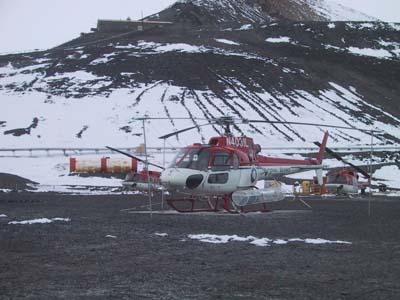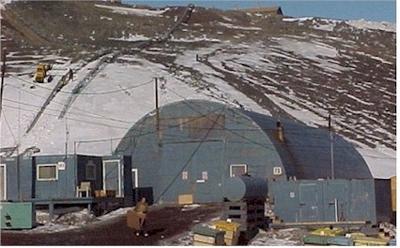23 December, 2002
More Field Preps
Going out to the field will be a big task because of the preparations
required. During the month of January we will be in the Dry Valleys for
three weeks and won't be coming back and forth to McMurdo. While there are
some base camps set up in various areas of the Dry Valleys, ours will
consist of only what we bring to Bull Pass. In other words, we need to be
sure we bring the right equipment and that the equipment has been checked
ahead of time to be sure it works. A sleeping bag with a broken zipper, a
backpack with a missing strap, or a stove that leaks needs to be identified
before we go to the field. We will "pre-flight" everything before leaving
McMurdo. We have divided up the responsibilities for equipment, procedures,
etc. among our group. We also assign more than one person to each area so
that we have an extra person covering each responsibility. Because of my
Navy background I will be primarily responsible for radios and helicopters
operations. There are a number of people on the station to visit for briefs
and procedures and everyone I've talked with has been very helpful,
organized, and knowledgeable.
Today, Sarah and I visit the helo hanger to talk to Mike McClanahan about
operations and requesting helicopter support in the field. We are going to
use the helicopters to get all of our equipment, including us, to the field
so we need to know what the rules are. We spend an hour talking with Mike.
Sarah needs to go to another appointment about the procedures for drawing
the food stocks we'll need so Mike and I finish up by heading over to the
passenger terminal to discuss what the check in procedures will be like on
our first flight day.
Later, we all work together at the Berg Field Center (BFC) where Taber and
Amanda have been continuing to inventory the equipment that has been
previously requested. We have a "cage" set aside in the BFC for storing our
field equipment including survival bags which we learned about at snow
school. Not only is the equipment inventoried but Taber and Amanda are
making sure it's in good condition. A good chunk of time is spent by all of
us putting together the large "Endurance" tents we will use. In the field,
Taber and I will share one along with the cooking gear. Sarah, Karina, and
Amanda will be in the other Endurance tent. Bruce (who should be here in a
little over a week) will use a Scott tent. The Scott tents are the big
yellow pyramid shaped ones you saw in the snow school journal entry. Bruce
will be by himself but will need space for the maps, charts, and other
reference material essential to the geology project.
We have another excellent meal at the galley and return to set up the
Endurance tent that the ladies will use. The Endurance tents are pretty
big. Ours will measure about 8 feet by 16 feet and the women's tent is
about 8 feet by 21 feet. You can easily stand up inside and walk around.
Taber and I joke that they are like circus tents but they should be a bit
cozier when we start putting gear inside. They're very strong and have an
internal liner which essentially makes it a double walled tent. We will
have cots and tables going in. The sleeping bags are known as "Arctic
Storms" and we used them at snow school. Very comfortable. There's also a
fleece liner and thermarest air mattresses that we'll be using. For Davis
A., whose family does a lot of winter camping, I think you would approve.
By the way Davis, we have camping chairs as well.
We are setting the tents up indoors and it's good practice to see how all
the poles and fasteners go together. The largest tent needs a little minor
patching here and there so we'll leave this one up. One of the folks at the
BFC will take care of that for us during the next couple of days. If we're
lucky when we get to the Dry Valleys, there won't be a lot of wind when we
need to set up the tents. If there is then this could be a challenge to
put up.
Karina and I test the camp stoves (we have three) while Sarah makes labels
for all our gear that will be packed and delivered to the helos starting
three days prior to the flight. We take all the labeled gear to be weighed
and once again we are in luck when Joe, who works at the cargo warehouse
next door, tells us he will help us with containerizing our gear into two
large tri-walled boxes for easier shipment to the field. This is great
because it means we could be finished with a major part of our field preps
by the end of the day today and not have to return the equipment to the
cage. It's as if we have these massive "suitcases" we can put everything
into: packed and ready to go. Just to be sure, Joe arranges for one of the
helicopter load technicians to come over to look over what we're doing and
give us his approval. We finish the day knowing that the majority of our
gear (we still have to think about food, but that's another day) will be
packed and ready for what the helo folks will carry in a "sling load"
beneath the helicopter the day we deploy. Between the discussion earlier in
the day with Mike and what we've just heard it sounds like we'll either have
two helicopters to get us set up on the first day or one that makes multiple
trips. Either way things seem to be coming together nicely.
Tomorrow: Christmas Eve in Antarctica

1. The station uses helicopters for logistics and to support the scientists in the field

2. A Bell-212 helicopter makes an approach to McMurdo Station

3. An Endurance tent is set up inside the Berg Field Center

4. Amanda conducts an inventory of cooking equipment

5. The cargo warehouse
Contact the TEA in the field at
.
If you cannot connect through your browser, copy the
TEA's e-mail address in the "To:" line of
your favorite e-mail package.
|
